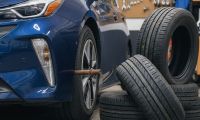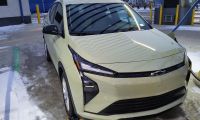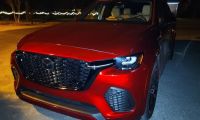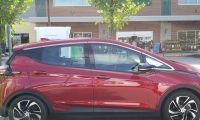Hyundai continues its evolution as a car company with its new EV platform called E-GMP. Here are five things you should know about the platform that should help the Korean automaker quickly become a dominant player in the electric vehicle space against major competition from Tesla and Ford.
Let’s be honest. No manufacturer in the EV space can hope to compete without taking on the 800-pound gorilla in the room. This new platform, along with Hyundai’s previous news about a 10-vehicle EV lineup, directly targets Tesla.
Yesterday we shared the news from Hyundai about the new electric-vehicle dedicated platform called E-GMP. In addition to Hyundai vehicles, it will also be placed in a new Kia vehicle to be unveiled in 2021.
5 Things To Know
Here are some of the key points directly from Hyundai. A lot of technical detail is included for those who follow electric vehicles closely and want to know more of the details.
The E-GMP’s compact new power electric system consists of a powerful motor, EV transmission and inverter. These three components are integrated into a single compact module. This module raises the motor’s maximum speed by up to 70% compared to existing motors. The high-speed motor is smaller than other motors while providing comparable performance, and it gives efficiencies in both space and weight.
Additionally, a standardized battery system can be tuned to offer performance appropriate for a specific vehicle segment, to maximize driving range, or to meet various customer needs.
The battery pack itself – mounted between the front and rear wheel axles – will be the most power-dense system that Hyundai Motor Group has ever created. This is partly thanks to its enhanced cooling performance, a result of a new separate cooling block structure which helps make the battery pack more compact. With energy density enhanced by around 10% compared to existing EV battery technology, the battery packs are lighter, can be mounted lower in the body, and liberate more cabin space.
Adaptable Charging System
OK, I’m going to defer to the Hyundai experts on this explanation. My attempts to edit it will only lead to confusion.
E-GMP offers 800V charging capability as standard and enables 400V charging, without the need for additional components or adapters. The multi-charging system is a world’s first patented technology which operates the motor and the inverter to boost 400V to 800V for stable charging compatibility.
A BEV based on E-GMP is capable of a maximum range of over 310 miles with a fully charged battery, according to the Worldwide Harmonized Light-duty vehicle Procedure (WLTP). Moreover, it can high-speed charge up to 80% in just 18 minutes and can add up to 60 miles of driving range in just five minutes. [Editor’s note: That’s really key for folks with house chargers who just need a quick jolt to get home.]
Unlike previous BEVs, which only accept one-way charging, the E-GMP’s charging system is more flexible. The E-GMP’s newly developed Integrated Charging Control Unit (ICCU) represents an upgrade from existing On-Board Chargers (OBC), which typically only allow electricity to flow in a single direction from an external power source. The ICCU enables a new vehicle-to-load (V2L) function, which can additionally discharge energy from the vehicle battery without additional components.
This enables BEV based on the E-GMP to operate other electric machinery (110 / 220V) anywhere. The system can even be used to charge another EV. Think about that. EVs can finally get roadside assistance if their batteries drain.
The new V2L function can supply up to 3.5kW of power and operate a mid-sized air conditioner unit and a 55-inch television for up to 24 hours.

Increased EV Safety
The platform secures battery safety through a battery support structure made of ultra-high strength steel. Hot-stamped steel components surround this structure for additional rigidity. Collision energy can be absorbed efficiently thanks to energy-absorbent sections of the body and chassis, effective energy load paths, and a central section of the battery pack tightly bound to the vehicle body.
By strengthening the structure of the load support section, located in front of the dashboard, engineers have been able to minimize collision energy to the power electric system and battery. The A-pillar’s load distribution structure also prevents deformation of the passenger cell.
You have to love the way car companies “talk.” Preventing “deformation of the passenger cell” means the passenger cabin’s not going to crumple like a pawn shop accordion in a collision.

More Interior Space
E-GMP maximizes interior space through its long wheelbase, short front and rear overhangs and slim cockpit module. With the battery pack mounted beneath the floor, the E-GMP creates a flat floor for the cabin. This provides more legroom for passengers, while enabling various arrangements for the front and rear seats.
This can’t be stressed enough. Today’s EVs are really comfortable. Older drivers should strongly consider them. A vehicle like the Chevy Bolt, for example, has wide doors, good shoulder room, and lots of legroom. Plus, people who drive less should consider EVs because they eliminate trips to gas stations.

Rear-Wheel Drive
E-GMP relies on the rear wheels for propulsion. Customers will be able to choose between rear-wheel and all-wheel drive configurations; models with the latter can be equipped with an additional motor.
The all-wheel drive system includes an EV transmission disconnector, which can control the connection between the additional motor and front wheels, and switch between two-wheel and all-wheel drive modes to enhance efficiency by offering the ideal level of power or performance for current driving conditions.
Rear-wheel drive vehicles are just more fun to drive. Hyundai has already shown us the glorious Prophecy EV concept. This new platform bolted to that vehicle will produce something amazing to drive.
Keith Griffin covers Hyundai and Kia at Torque News. He has been writing continuously about cars since 2002. Keith used to be a researcher/writer for US News & World Report, as well as numerous car sites, including Carfax and Car Gurus, and a contributor to The Boston Globe. Most recently, Keith was the managing editor for American Business Media. Follow Keith at @indepthauto on Twitter, on @LinkedIn and on his Indepth Auto Facebook page.












